James Edward Buttersworth stands as a preeminent figure in nineteenth-century marine art, an Anglo-American painter whose canvases vividly captured the dynamism and elegance of maritime life during a transformative era. Born in England but achieving his greatest fame in the United States, Buttersworth's meticulous attention to detail, dramatic compositions, and profound understanding of seafaring vessels earned him a lasting legacy. His work not only documented the majestic clipper ships and thrilling yacht races of his time but also imbued these scenes with a palpable sense of atmosphere and motion, securing his place as a master of the genre.
Early Life and Artistic Formation
James Edward Buttersworth was born in Isleworth, Middlesex, England, in 1817. His artistic inclinations were nurtured from a young age, heavily influenced by his father, Thomas Buttersworth (c. 1768–1842). The elder Buttersworth was himself a respected marine painter, known particularly for his depictions of naval engagements during the Napoleonic Wars. Growing up in this environment, James received his foundational art education directly from his father, inheriting a deep appreciation for maritime subjects and the technical skills needed to render them accurately.
The artistic tradition James was born into was rich and well-established. British marine painting had flourished with artists like Charles Brooking and Nicholas Pocock, who documented the nation's naval power and maritime trade. Thomas Buttersworth built upon this legacy, and James, in turn, absorbed these influences. His early works, produced in England, naturally reflected his father's style, characterized by competent draftsmanship and a focus on naval history and ship portraiture. This initial training provided a solid basis for the distinct style he would later develop.
Emigration and a New World Perspective
In 1845, seeking new opportunities and perhaps a broader canvas for his talents, James E. Buttersworth emigrated to the United States. This move marked a pivotal point in his life and career. He initially settled in New York City, the bustling heart of American maritime commerce. The energy of the port, teeming with ships from around the globe – sleek clipper ships, early steam vessels, and coastal craft – offered endless inspiration. The timing was fortuitous, coinciding with America's burgeoning confidence and rapid expansion in international trade and shipbuilding.
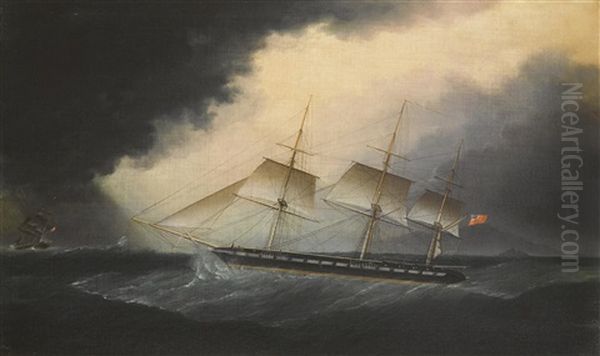
Around 1850, Buttersworth relocated his residence across the Hudson River to West Hoboken, New Jersey (now part of Union City). This location provided him with panoramic views of New York Harbor, allowing him to observe firsthand the constant parade of ships and the dramatic interplay of light and weather on the water. His American experience profoundly shaped his artistic output. While retaining the technical precision learned in England, his work began to capture the unique spirit and dynamism of the American maritime scene, particularly the celebrated speed and grace of American-built vessels.
The Artist's Eye: Style and Technique
Buttersworth developed a distinctive artistic style characterized by meticulous detail, dramatic compositions, and a remarkable ability to convey movement and atmosphere. While influenced by his father, James's style evolved, becoming more refined and often more dynamic. He excelled in portraying ships with accuracy, capturing the intricacies of rigging, hull design, and the way sails caught the wind. His understanding of naval architecture was clearly profound, lending authenticity to his depictions.
He often employed a low horizon line and dramatic cloudscapes, enhancing the sense of scale and the power of the sea. Light played a crucial role in his work; he masterfully rendered the effects of sunlight breaking through clouds, the glow of dawn or dusk, and the turbulent skies of approaching storms. Buttersworth frequently utilized diagonal perspectives, positioning vessels cutting through the waves to emphasize their speed and elegance. This compositional device became a hallmark of his yachting scenes.
Buttersworth was adept with oil paints, often using thin glazes to achieve luminosity and depth. He worked on various supports, including canvas, millboard, wood panels, and occasionally metal sheets. This versatility allowed him to adapt his technique to different scales and desired effects. His brushwork, while precise in rendering detail, could also be fluid and expressive, particularly in capturing the movement of water and the texture of clouds.
Capturing the Age of Sail and Steam
Buttersworth's oeuvre provides a remarkable visual record of mid-nineteenth-century maritime life. He painted a wide array of vessels, from the majestic square-rigged clipper ships that dominated transoceanic trade to the powerful early steamships heralding a new era of propulsion. His ship portraits were highly sought after by owners, captains, and merchants who desired accurate and often dramatic representations of their vessels.
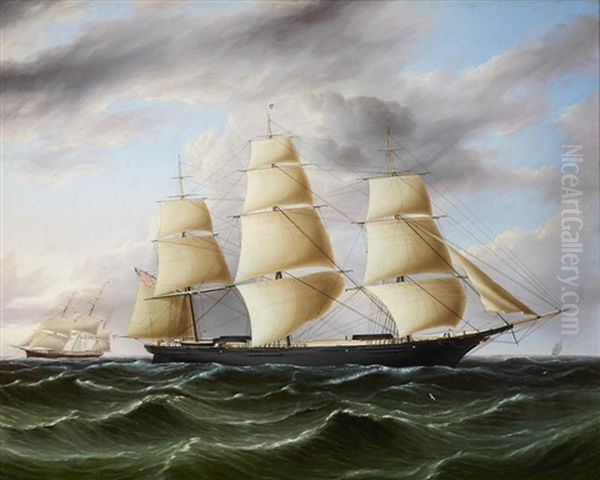
He captured the essence of the "Golden Age of Sail," depicting famous clipper ships like the Flying Cloud or the Challenge in various conditions – battling heavy seas, racing under full sail, or navigating busy harbors. These paintings were more than mere records; they conveyed the romance and peril associated with long sea voyages. Buttersworth also documented the transition to steam power, painting steam-sail hybrids and dedicated steamships, reflecting the technological changes transforming maritime transport.
His depictions often included recognizable landmarks, particularly around New York Harbor, such as Castle Garden or Sandy Hook, grounding his scenes in specific locations. This specificity added to their documentary value and resonated with his American audience. The accuracy of his work made his paintings valuable historical documents, consulted even today for insights into ship design and maritime practices of the period.
The Thrill of the Race: Yachting and the America's Cup
James E. Buttersworth is perhaps most celebrated for his vibrant depictions of yacht racing, particularly the America's Cup contests. He became the foremost visual chronicler of this prestigious event during its formative decades. The mid-to-late nineteenth century saw a surge in the popularity of yachting as a sport among the affluent, and Buttersworth captured the excitement, elegance, and competitive spirit of these races like no other artist.
He witnessed and painted numerous America's Cup races, documenting legendary yachts such as America (whose victory in 1851 initiated the Cup), Magic, Puritan, Mayflower, and Volunteer. His paintings of these events are prized not only for their artistic merit but also as crucial historical records of the races, capturing specific moments of competition against the backdrop of New York Harbor or Newport, Rhode Island. His work often served as the basis for illustrations in newspapers and magazines covering the races.
One notable example of his skill in this area is Cat Boat Race, depicting smaller vessels competing fiercely, showcasing his ability to capture speed and tension even in less grand subjects. His yachting scenes are characterized by dynamic compositions, often showing the yachts heeled over under a strong breeze, spray flying from their bows, conveying an exhilarating sense of speed and motion. He received commissions from prominent yacht owners and clubs, solidifying his reputation in these circles. His dedication to the subject earned him accolades, including awards related to his America's Cup depictions in the 1880s and 1890s.
Master of Atmosphere and Drama
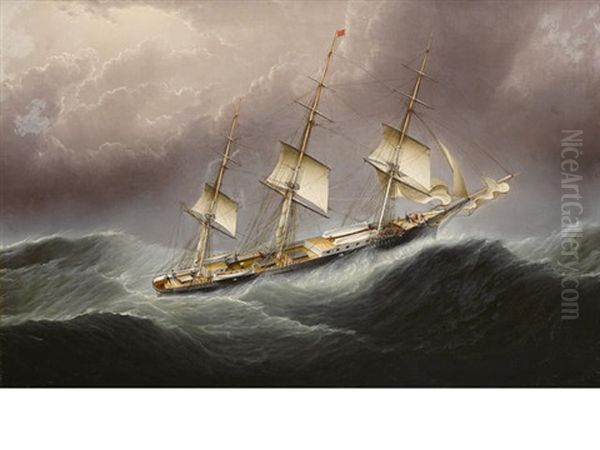
Beyond the accurate portrayal of vessels, Buttersworth possessed an exceptional talent for capturing the mood and atmosphere of the sea. His skies are rarely passive backdrops; they are active elements contributing to the drama of the scene. He depicted towering cumulus clouds, stormy squalls, serene sunsets, and hazy mornings with equal skill, demonstrating a keen observation of meteorological effects.
His painting American Frigates in a Storm exemplifies his ability to convey the power and danger of the sea. The ships are shown battling tumultuous waves under dark, threatening skies, evoking a sense of struggle and resilience. Conversely, works like American Yachts at Dusk showcase his capacity for capturing tranquility. In this piece, the soft, warm light of the setting sun bathes the scene, reflecting off the calm water and highlighting the graceful lines of the yachts, creating a mood of peaceful elegance.
This mastery of light and atmosphere elevates Buttersworth's work beyond mere ship portraiture. He understood that the sea itself was a character in his paintings, its changing moods dictating the drama and emotional resonance of the scene. His ability to integrate the vessel, the water, and the sky into a cohesive and evocative whole is a testament to his artistic vision.
Collaboration and Popular Reach: Currier & Ives
Buttersworth's influence extended beyond the world of fine art collectors thanks to his collaboration with popular printmakers, most notably Currier & Ives. This New York-based firm specialized in producing affordable lithographs for the mass market, covering a wide range of subjects, including maritime scenes. Currier & Ives acquired the rights to reproduce many of Buttersworth's paintings as lithographs.
These prints brought Buttersworth's depictions of famous ships, naval battles, and yacht races into ordinary American homes. While the lithographs inevitably simplified some of the nuances of his original paintings, they retained the core composition and dramatic flair, popularizing his vision of American maritime prowess and beauty. This collaboration significantly broadened his reach and name recognition, making his imagery synonymous with the great age of American sailing. His work was also featured in publications like the New York Times and The New Yorker, further cementing his public profile.
Context: Contemporaries and Influences
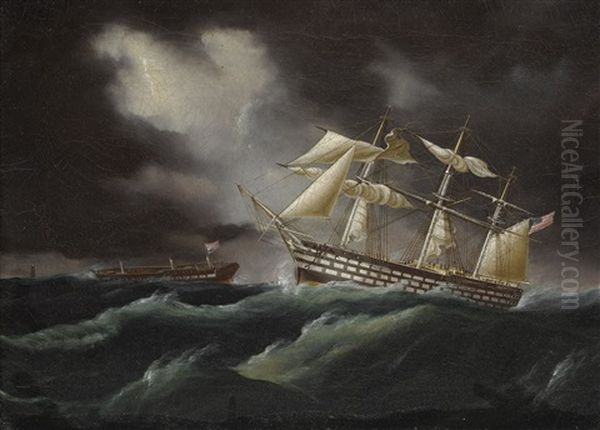
James E. Buttersworth worked during a vibrant period for marine painting on both sides of the Atlantic. His father, Thomas Buttersworth, was a key early influence. In America, he joined a growing school of talented marine artists. Robert Salmon (1775-c.1845), another British émigré working primarily in Boston, preceded him and was known for his crisp, detailed harbor scenes. Fitz Henry Lane (1804-1865), a leading figure of Luminism, created serene and light-filled coastal views, offering a contrast to Buttersworth's often more dramatic style.
Other notable American contemporaries included William Bradford (1823-1892), famed for his Arctic scenes but also a capable marine painter, and James Hamilton (1819-1878), known for his more romantic and turbulent seascapes. Antonio Jacobsen (1850-1921), a Danish-American artist, became incredibly prolific, painting thousands of ship portraits in a precise, though perhaps less atmospheric, style than Buttersworth. Edward Moran (1829-1901) and his brother Thomas Moran (1837-1926), though the latter is more famous for Western landscapes, also contributed to marine art. Later figures like Winslow Homer (1836-1910) would bring a powerful, different sensibility to marine subjects.
Buttersworth's work can also be seen in the context of earlier European traditions, drawing from Dutch Golden Age masters like Willem van de Velde the Elder and Younger, and British predecessors such as Dominic Serres (1719-1793) and Nicholas Pocock (1740-1821), who established conventions for depicting naval accuracy and atmospheric effects. While clearly part of these traditions, Buttersworth forged his own path, particularly in his focus on the speed and dynamism of American vessels.
Legacy and Collections
James Edward Buttersworth died in 1894 in West Hoboken, New Jersey, leaving behind a substantial body of work estimated at 600 to 800 paintings. His reputation as a premier American marine artist has endured. His paintings are highly valued for their artistic quality, historical accuracy, and evocative portrayal of a significant era in maritime history. They are considered among the pinnacles of American marine art from the nineteenth century.
His works are held in numerous prestigious public and private collections. Major museums featuring his paintings include the Metropolitan Museum of Art in New York City, the Mystic Seaport Museum in Connecticut, the Peabody Essex Museum in Salem, Massachusetts, the US Naval Academy Museum in Annapolis, the National Maritime Museum in Greenwich, London (which holds a collection of his father's work and some related items), the New Jersey State Museum, the Princeton University Art Museum, the Maine Maritime Museum, the Penobscot Marine Museum, the Farnsworth Art Museum, and the RISD Museum, among others.
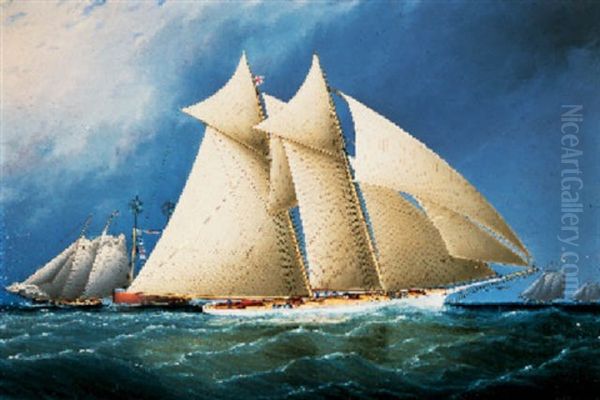
The enduring appeal of Buttersworth's work is also reflected in the art market. His paintings consistently command high prices at auction. For instance, significant works depicting clipper ships or important yacht races have sold for hundreds of thousands of dollars. A painting of the clipper Black Warrior was estimated at 0,000-0,000, and other sales, like one achieving 3,000 at Christie's in 2008, underscore his status as a blue-chip artist in the field of marine art.
Conclusion
James Edward Buttersworth masterfully bridged the traditions of British marine painting with the burgeoning spirit of nineteenth-century America. His canvases are more than just depictions of ships; they are vibrant narratives of speed, competition, commerce, and the elemental power of the sea. Through his meticulous detail, dramatic compositions, and sensitivity to light and atmosphere, he chronicled the Golden Age of Sail and the excitement of early yacht racing with unparalleled skill and passion. His legacy endures not only in the galleries of major museums and the catalogues of auction houses but also in the enduring imagery that helps define America's rich maritime heritage. He remains a pivotal figure for anyone interested in marine art or the history of the sea.